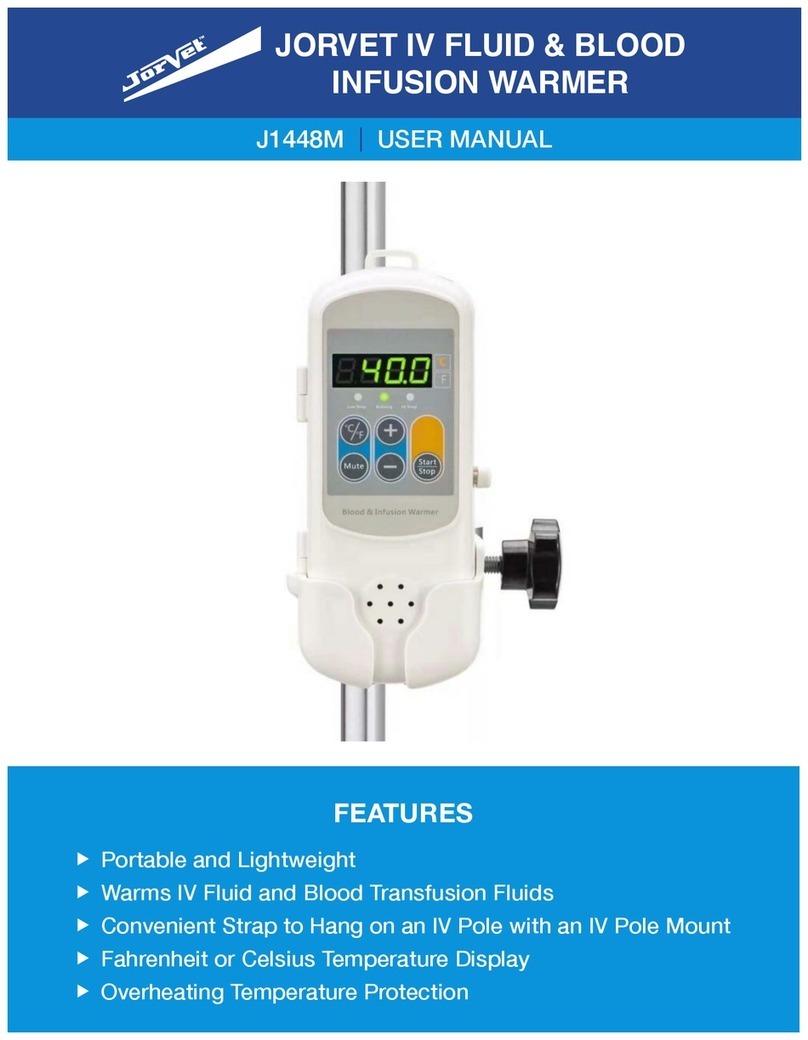
Spring
Braided Wire
Carbon Bar
Length
Reading Microhematocrits
After the rotor has stopped, remove the cover plate by unscrewing the chrome thumbscrew and lifting the cover plate
straight up.
Place the reader disc over the hematocrit tubes, and adjust the disc until the 0% line is lined up with the bottom of the fluid
in the tube to be read.
While keeping the 0% line positioned at the bottom of the fluid, turn the disc until the 100% line aligns with the top of the
fluid.
Read the separation line in the middle for your microhematocrit results.
1
2
3
4
If you purchased a microhematocrit rotor, it includes a Reader Disc, which allows the tubes to be read directly from the rotor.
Care, Maintenance, Trouble-Shooting
Use only quality test tubes. Lower-quality plastic or glass tubes may fracture and release their contents into the tube cham-
ber.
Never force a tube into the tube shields. Some plastic conical test tubes are too large and should not be used.
Never hang a tube by its cap. Always make sure the tubes are supported by the bottom of the shield, or with a rubber cush-
ion.
Use only 75mm capillary tubes with the 24-place microhematocrit rotor.
Clean the inside of the centrifuge regularly. Always unplug electrical power before cleaning. Whenever there is a tube
breakage or a spill, it is recommended that the inside of the centrifuge be cleaned, and if possible, disinfected (do not
immerse the electrical components in any liquid).
Motor and electrical maintenance: The Combo V24T utilizes a brushed motor, which includes bearings that are permanent-
ly lubricated. Likewise, the electrical components were designed for high reliability and should not need regular service,
other than brush replacement. However, if repairs or brushes should be needed, please contact Jorgensen Laboratories.
If the centrifuge will no longer maintain speed, inspect and/or replace the brushes. The life of the brushes depends upon
several factors (speed, load, duty cycle, etc.). To ensure optimum performance, we recommend you check the motor
brushes every 6 months. This will help you recognize your typical wear pattern and ensure the motor brushes are serviced
properly.
When new, the carbon bar of the motor brushes measures approximately 1/2” in length (see image below). The brushes
wear and should be replaced when the carbon bar reaches 1/4” in length. Operating your centrifuge with a carbon bar
that has worn beyond this point can damage the centrifuge motor.
When inspecting/replacing brushes, we recommend you blow out the motor/brush area with canned air. Excessive dust,
dirt, and hair can interrupt the brush contact and decrease performance.
1
2
3
4
5
6
7
8If you have difficulty removing your rotor, you may have light oxidation on the motor shaft. To correct this we recommend
a clean—polish—clean procedure. Clean the motor shaft with alcohol. Polish it with 400-grit or finer sandpaper. Clean the
shaft again. Then, apply a small amount of household grease to the motor shaft. Do NOT use oil or spray lubricants such as
WD-40.
To prevent the reoccurrence of oxidation on the motor shaft, we recommend servicing it approximately once per week by
cleaning with alcohol and reapplying household grease. This should alleviate the issue.
Display comes on - Will not spin: Check to make certain the lid safety switch (near the back right hinge) is engaged. With
the power on and the timer set, depress the button with your finger. If the rotor spins, turn the safety switch button count-
er-clockwise to raise the height and allow it to contact the lid when it is closed.
No light - Not spinning: Confirm that your power source is working. Check the 6.3 amp fuse and replace if the filament is
broken. Speed slows down or stops...the brushes may need to be replaced on the motor after 1000 +/- hours of use if speeds
have decreased. Contact Jorgensen Laboratories to purchase new brushes (part #CMP-BRSH-PR77).
Because of the safety issues with high g-forces in a centrifuge, it is recommended that rotors be inspected every 6 months
for corrosion and fatigue. If there is any indication of wear, the rotor should be removed from service. Contact Jorgensen
Laboratories for return instructions, so the rotor can be evaluated by an Jorgensen Laboratories technician for repair or
replacement. It is also recommended that after 2 years of service rotors and tube shields* be returned to Jorgensen Labo-
ratories for inspection. Following these procedures will ensure safety of lab personnel as well as extend the life of the centri-
fuge.
NOTE: Plastic tube shields should be replaced at least once a year. Tube shields should be inspected once a month for wear
or damage. Tubes that are being used in high volume applications should be replaced every three months or sooner.
9






















